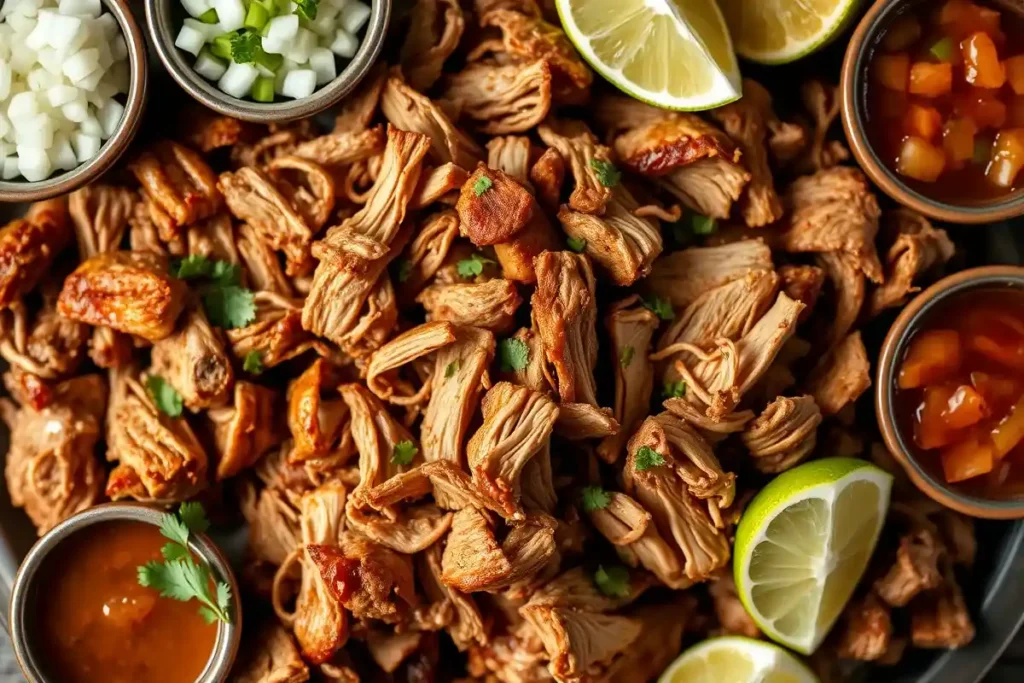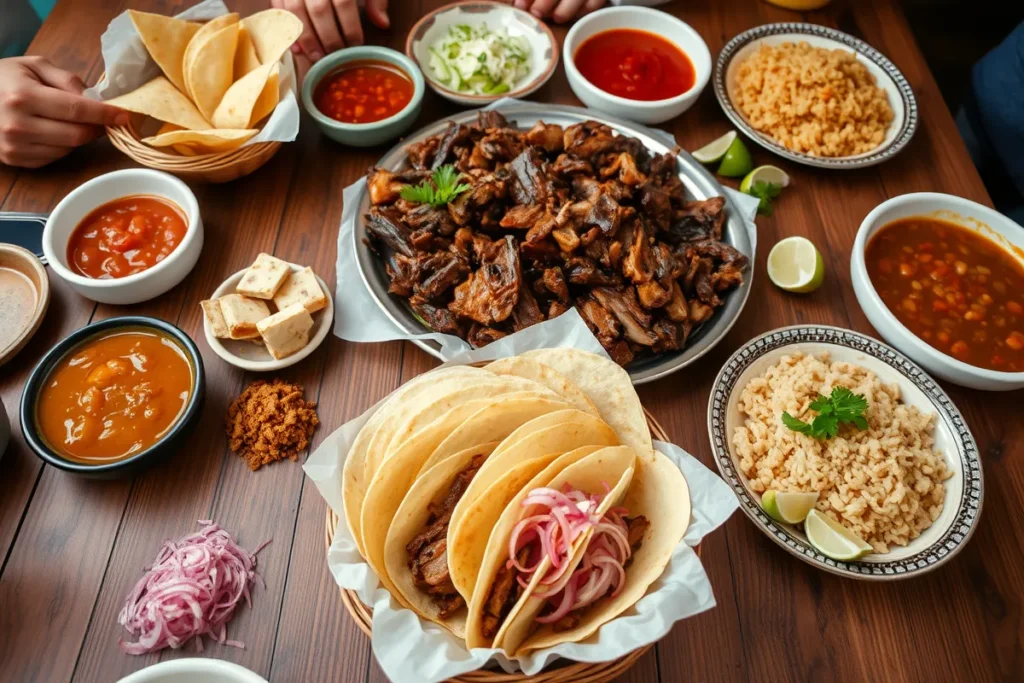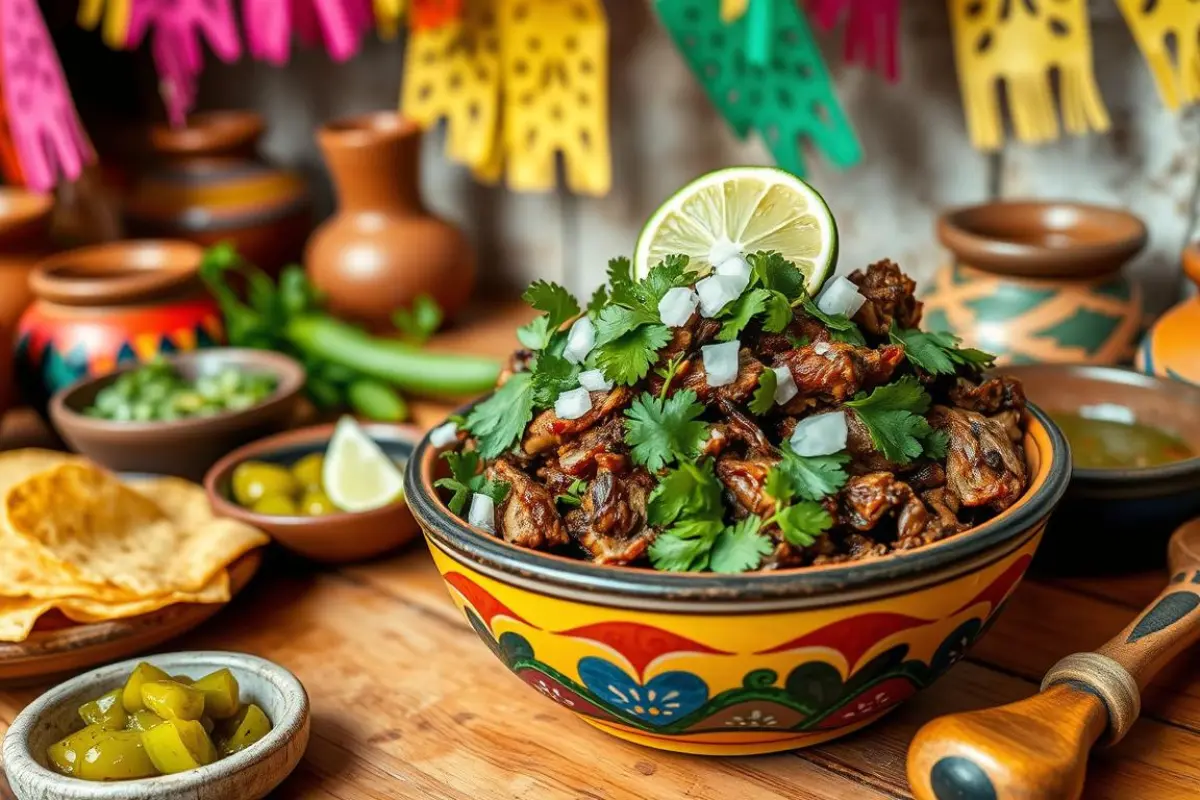Carnitas, the quintessential Mexican pork dish, has won the hearts of food lovers everywhere. In this guide, we will explore how to eat carnitas traditionally in 2025, covering everything from its origins to the best serving methods, ensuring you enjoy every bite.
Whether you’re a seasoned carnitas lover or new to it, knowing the traditional ways to enjoy it is essential. We’ll explore its rich history, key ingredients, and how to prepare and serve it. This will help you have a memorable dining experience in the years ahead.
Understanding Authentic Mexican Carnitas
Carnitas, a favorite Mexican dish, comes from Michoacán. It’s slow-cooked what is authentic carnitas made of? pork that’s been loved for generations. It’s known for its delicious mix of flavors and textures.
The Origins of Traditional Carnitas
The story of carnitas starts in Quiroga, Michoacán. People cooked pork in big copper pots. This made the meat tender and juicy on the inside, and crispy on the outside. This method has been passed down for centuries, making traditional carnitas serving methods what they are today.
Essential Ingredients in Authentic Carnitas
- Pork: The main ingredient, often a mix of pork shoulder and belly for the best taste.
- Spices: Spices like cumin, oregano, and garlic add deep flavor to the pork.
- Citrus: Orange or lime juice tenderizes the meat and adds a nice acidity.
The Traditional Cooking Process
The secret to real carnitas is slow cooking. Pork is cooked in a big pot with all the right ingredients. This makes the meat tender and full of flavor. Then, the pork is fried in its own fat to get that perfect crispy texture.

How Do You Eat Carnitas Traditionally?
Eating authentic Mexican carnitas is a special treat for the senses. It’s more than just filling your belly. It’s a way to celebrate culture and enjoy good food.
In Mexico, the best way to eat carnitas is with your hands. This lets you feel and taste the juicy pork. Using your fingers makes the experience even better.
Carnitas are often served on a platter with tasty sides. You might find warm tortillas, onions, cilantro, lime wedges, and salsas. These help you make your carnitas just right for you.
| Traditional Carnitas Accompaniments | Purpose |
|---|---|
| Warm Tortillas | To wrap and hold the carnitas |
| Diced Onions | To add crunch and a touch of sharpness |
| Freshly Chopped Cilantro | To provide a refreshing, herbal note |
| Tangy Lime Wedges | To balance the richness of the carnitas |
| Variety of Salsas | To add heat, acidity, and depth of flavor |
There’s a special way to eat carnitas in Mexico. It’s polite to take your time and enjoy each bite. Talking with others makes the meal even more fun.
Trying the traditional way of eating carnitas lets you dive into Mexican food culture. It’s a great way to enjoy carnitas fully.

The Perfect Texture: Achieving the Crispy-Tender Balance
Authentic carnitas need a perfect mix of crispy outside and tender inside. This balance is crucial for the best carnitas experience. Let’s look at how to get this right.
Techniques for Crisping Carnitas
To get that crispy outside, try these methods:
- Slow roast the pork at a low heat. This makes the fat melt and the meat tender.
- Finish with a high-heat broil or sear in a hot pan. This creates a golden, crispy crust.
- Let the cooked carnitas rest and cool a bit. Then, shred or chop them. This makes them crispier.
Signs of Perfectly Cooked Carnitas
Are carnitas supposed to be crispy? Yes, they should be! Perfect carnitas have these traits:
- A golden-brown, crispy outside.
- A juicy, tender inside that’s soft to the touch.
- Flavors that mix the pork’s sweetness with savory, caramelized edges.
- A crunchy bite followed by a soft, braised meat feel.
Mastering these techniques and knowing the signs of perfect carnitas will make your dish a hit. It will bring the flavors of traditional Mexican cuisine right to your table.
Essential Carnitas Accompaniments and Toppings
Carnitas, the famous Mexican slow-roasted pork dish, is best when paired with the right sides and toppings. These extras enhance the meat’s rich flavors and make the meal even better.
A fresh, vibrant salsa is a top choice for carnitas. Options like salsa verde or pico de gallo add a perfect balance. They cut through the pork’s fattiness with their bold flavors.
- Diced white onions, both raw and caramelized, add a crisp, pungent contrast to the tender carnitas.
- Fresh chopped cilantro lends a bright, herbal note that complements the rich meat.
- A squeeze of fresh lime juice provides a refreshing acidity that ties all the flavors together.
These traditional carnitas sides and toppings let you discover the best ways to enjoy carnitas. They bring out the full flavor of this iconic Mexican dish.
Traditional Serving Methods and Preparations
When serving do you drain carnitas?, there are classic ways to enjoy this Mexican dish. Carnitas are often served in a family-style setting. A platter of the crispy pork is the main attraction.
Common Serving Styles
One way to serve traditional carnitas serving methods is on a large platter. It’s surrounded by warm tortillas, onions, cilantro, and salsas. This lets guests make their own tacos or enjoy the pork alone.
Another way is to serve carnitas in individual portions. They’re placed in small bowls or on plates. This way, each person can choose their toppings and portion size.
Temperature and Timing Considerations
When serving do you drain carnitas?, temperature and timing matter a lot. Carnitas taste best when they’re hot. This highlights the crispy outside and juicy inside.
It’s key to serve carnitas when they’re at their best temperature. This keeps their texture and flavor just right.
Proper Draining Techniques
Before serving, make sure to drain the traditional carnitas serving methods well. This removes excess fat or liquid. It keeps the carnitas crispy and prevents them from being too greasy.
To drain, use a slotted spoon or place them on a paper towel-lined plate. This absorbs any extra moisture.
Best Side Dishes to Complement Your Carnitas
Enjoying authentic Mexican carnitas is even better with the right side dishes. Traditional carnitas meal ideas include many tasty sides that match the rich pork. Let’s look at some top choices for your carnitas.
Refried beans are a classic choice. They’re creamy and seasoned, making a great base for the carnitas. Another favorite is Mexican rice, which is fluffy and aromatic, contrasting nicely with the pork.
- Grilled or roasted vegetables, like bell peppers, onions, and zucchini, bring a fresh touch to the meal.
- Pickled red onions or jalapeños add a tangy, refreshing contrast to the carnitas.
- Cilantro and a squeeze of lime can also boost the meal’s flavor.
| Side Dish | How it Complements Carnitas |
|---|---|
| Refried Beans | Provides a creamy, substantial base |
| Mexican Rice | Offers a fluffy, aromatic contrast |
| Grilled Vegetables | Adds a fresh, vibrant element |
| Pickled Onions/Jalapeños | Cuts through the richness with tanginess |
| Cilantro and Lime | Enhances the overall flavor profile |
Adding these traditional Mexican sides makes your carnitas meal complete. Try different combinations to find your favorite carnitas pairings.
Creating the Ultimate Carnitas Taco Experience
Making the perfect carnitas taco is like a work of art. It’s all about the rich flavors and textures of this Mexican dish. From picking the right tortilla to layering the ingredients just right, every step is important. Let’s dive into the secrets of making the ultimate carnitas taco.
Tortilla Selection and Preparation
The base of a great carnitas taco is the tortilla. Choose freshly made corn tortillas for the best balance of strength and softness. Small, hand-pressed tortillas add a traditional touch. Warm them on a comal or griddle to make them even more inviting for the carnitas and toppings.
Building the Perfect Taco Layer by Layer
- Begin with a big helping of slow-cooked carnitas. Make sure each taco is packed with the main attraction.
- Add diced onion and cilantro on top. They bring a fresh crunch and herbal flavor to balance the meat.
- Drizzle some tangy, homemade salsa or green salsa. It adds a bright contrast to the rich carnitas.
- For creaminess, add a spoonful of queso fresco or shredded Oaxaca cheese.
- Finish with a squeeze of fresh lime juice. It cuts through the meat’s fattiness and boosts the flavors.
By layering these ingredients with care, you’ll make a taco that’s a perfect mix of textures and tastes. It truly shows how to serve and enjoy carnitas.
You May Also Like:
- What Pairs with Carnitas? 6 Must-Have Sides for a Complete Feast
- What Is the Difference Between Pulled Pork and Carnitas?
- Why Do You Put Orange Juice in Carnitas? Cooking Tips
- What Is Traditionally Served with Carnitas? – Side Dishes
- Carnitas Breakfast Recipe with Eggs: A Delicious Mexican Dish
Common Mistakes to Avoid When Eating Carnitas
Enjoying carnitas is a delightful experience. But, there are common mistakes that can ruin the taste and texture. To fully enjoy your carnitas, follow these tips.
- Avoid over-saucing your carnitas. The pork should be the main attraction. So, use sauces and condiments lightly to let the natural flavors stand out.
- Refrain from using the wrong utensils. Traditional carnitas are best eaten with your hands or small forks. Heavy knives can tear the tender meat.
- Don’t neglect the traditional accompaniments. Carnitas are often served with fresh tortillas, diced onions, cilantro, lime wedges, and salsa. These are key to the full carnitas experience.
- Steer clear of overcrowding your plate. Carnitas are meant to be savored slowly. Don’t overload your plate. Enjoy each bite.
By avoiding these common mistakes, you can enjoy carnitas the right way. This honors the traditional carnitas serving methods that make it so loved.
| Common Carnitas Eating Mistakes | Recommended Practices |
|---|---|
| Over-saucing the meat | Use sauces and condiments sparingly |
| Using inappropriate utensils | Eat with hands or small forks |
| Neglecting traditional accompaniments | Serve with tortillas, onions, cilantro, lime, and salsa |
| Overcrowding the plate | Take your time and savor each bite |
Conclusion
Enjoying carnitas in the traditional Mexican way is a real treat. It’s all about the authentic methods and the bold flavors. You can make your carnitas meals even better by focusing on the right texture and pairing them with great sides.
Try different ways of serving to find what you like best. Whether it’s for a big party or a cozy night alone, adding how to serve carnitas and carnitas meal ideas to your cooking will make your meals unforgettable. Discover the rich history and cultural importance of this Mexican favorite. Let your taste buds lead you on a tasty adventure with carnitas.
So, when you enjoy carnitas next, make sure to stick to the traditional ways. Try new flavor mixes and dive into Mexico’s vibrant food culture. Enjoy your meal!
Frequently Asked Questions (FAQs)
How are you supposed to eat carnitas?
Carnitas are best eaten with your hands. The pork is tender and flavorful. It’s meant to be picked up and enjoyed.
What is authentic carnitas made of?
Real carnitas use pork, like shoulder and belly. They’re cooked slowly in lard or oil until tender. Onions, garlic, oregano, and citrus juices like orange or lime are also key.
Are carnitas supposed to be crispy?
Yes, good carnitas have a crispy outside and a juicy inside. The slow cooking makes the fat render and the crust caramelized. This balance is key to authentic carnitas.
Do you drain carnitas?
Yes, draining carnitas is important. After cooking, the pork is removed and crisped up. This step removes excess fat and gives the right texture.
What are the traditional serving methods for carnitas?
In Mexico, carnitas are often served on a platter or in a communal dish. Guests can make their own tacos or tostadas. They may also be served on a plate with toppings like onions, cilantro, and lime.
What are the best toppings for carnitas?
Traditional toppings include diced onion, cilantro, and lime juice. These add a refreshing contrast to the rich pork. Salsa, green or red, is also a favorite for its flavor.
What are some traditional side dishes to serve with carnitas?
Classic sides include refried beans, Mexican rice, and grilled vegetables. Salsas add flavor. These sides make a complete meal with carnitas.
How can you create the ultimate carnitas taco experience?
Start with warm tortillas, corn or flour. Add the carnitas, then your favorite toppings like onions, cilantro, and lime. A drizzle of salsa or queso fresco adds extra flavor. The goal is to balance the rich carnitas with fresh, vibrant toppings.

